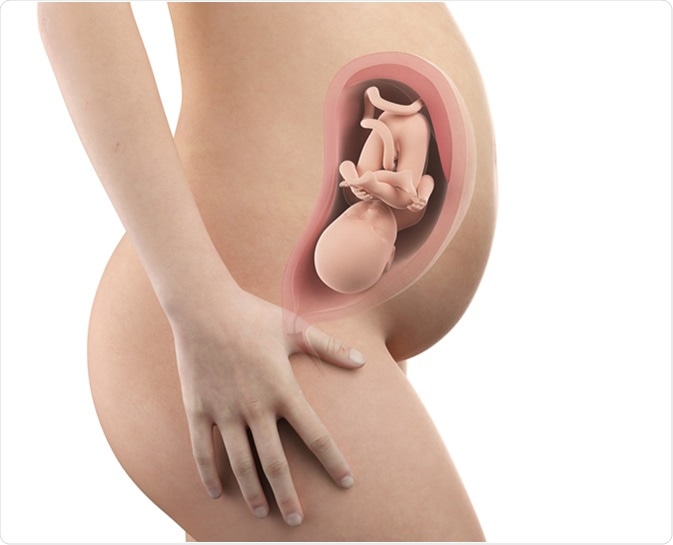Baby Not Moving as Much Need a Growth Ultrasound
Skip to:
- Is Reduced Fetal Motion Important?
- Why are Reduced Fetal Movements Worrying?
- Is it Bad When the Baby Moves likewise Much?
- How Exercise We Test for Fetal Wellbeing?
- Summing Up

Paradigm Credit: Gorodenkoff / Shutterstock
Nearly doctors and significant women would say they feel more at ease when the babe is moving regularly. A fetal move (kicking, scroll, or flutter) is usually commencement perceived at 18 to 20 weeks of pregnancy.

Pregnant woman with visible uterus and fetus week 19 - IllustrationImage Credit: Sebastian Kaulitzki / Shutterstock
The number of movements increases steadily until almost 32 weeks of pregnancy, and and then remains more or less constant until the babe is born.

Pregnant woman with visible uterus and fetus week 32 - IllustrationImage Credit: Sebastian Kaulitzki / Shutterstock
Most babies remain still while they sleep, for about xc minutes or less at a fourth dimension. At other times, they may be felt to movement for episodes lasting twenty to 40 minutes throughout the day.
Individual babies have their ain patterns of move. Even though the baby is short of room at the finish of a pregnancy, because of increasing fetal weight, fetal movements remain stiff and regular. However, if the baby doesn't motility well for a long time, something may exist incorrect.
Is Reduced Fetal Movement Of import?
Almost half of all meaning women who take access to medical intendance may enquire for help considering of perceived reduction in fetal movements.
Sometimes this is due to factors such every bit excessive fluid around the baby, unusual fetal position, an anterior placenta, an overweight mother, a first-time female parent, or a history of smoking.
Sometimes the mother doesn't notice fetal movements because they are distracted. In most of these cases the infant is healthy.
Even so, decreased fetal motion may indicate a higher risk of fetal affliction or expiry in almost 25% of cases, chiefly because of impaired oxygen and claret supply. In cases of intrauterine death, the fetal movements terminate altogether for 24 hours or more beforehand. Therefore, in cases like these the health of the babe must exist checked.
The most common way to differentiate between a imitation and true perception of contradistinct fetal movements is to do the so-chosen 'kick count'. However, in cases where the baby's health is compromised this test is non useful equally information technology is positive just subsequently the babe has suffered permanent damage.
In practical terms, in many cases the mother'due south feeling that the baby is moving less is an equally of import indicator of fetal distress.
Why are Reduced Fetal Movements Worrying?
In many cases, reduced fetal movements have been related to lower growth rate and a higher rate of stillbirth.
With low placental menstruation, the baby moves less to compensate for its insufficient placental supply. Withal, babies typically motility more when they are hungry, or when the blood sugar level in the mother drops.
If this is absent, it could indicate that the babe is so weak that information technology cannot even seek food, and therefore needs urgent help.
Another reason for reduced fetal movements tin can exist the result of the mother supplying too much blood carbohydrate to the baby, equally in maternal diabetes or prediabetic states. This is considering oxygen is used to metabolize glucose, leaving little for fetal activity.
Is it Bad When the Babe Moves too Much?
Fetal movements typically increment when the mother is hungry, reflecting lowered blood saccharide levels in the mother and fetus. This is similar to the increased activeness of most animals when they are seeking food, followed by a period of quietness when they are fed.
Information technology is possible that smaller babies move more than when they are hungry or when their blood sugar level is dropping, considering they are already receiving less food via the placenta for some reason, compared to larger babies with a skillful placental supply.
A more than serious miracle is the occurrence of a unmarried sudden episode of unusually vigorous fetal movements at the cease of a pregnancy.
This has been linked in one report to a sevenfold risk of stillbirth. Several possible causes are listed, including lack of oxygen supply or infection leading to seizures, or the fetus trying to get complimentary of the umbilical cord entangled around some office of the body.
This blazon of motility, described equally "frantic" or "crazy", is in contrast to the increased strong and frequent movements felt in normal pregnancy towards term.
How Do We Test for Fetal Wellbeing?
Ways to check if the change in fetal movement is of concern include:
- Cardiotocography, where the fetal center rate is observed for its baseline rate and short-term variability, equally well as for accelerations with fetal movement, is normal in 97% of active fetuses. Isolated tardily decelerations with other features being normal are non usually a sign of fetal distress every bit previously thought, as in many cases they are due to fetal animate movements, a sign of fetal health.
- Doppler ultrasound can help observe early signs of poor placental claret supply and poor fetal growth (FGR, fetal growth brake), typically but after almost a 3rd of the placenta is affected, in the form of altered blood catamenia through the umbilical avenue and veins. This method is more commonly used in Europe than the USA.
- Fetal biophysical profile is another method used to assess fetal health, but abnormality is mostly very tardily to occur, though one study showed it to be more sensitive in predicting a poor commitment outcome than Doppler ultrasound of the umbilical artery
Normal Fetal Movement and Growth | Kaiser Permanente
Summing Up
It is recommended that if a mother feels whatever more than than momentary change in fetal movements, the healthcare provider should ostend that the baby is well.
Formal fetal movement counts of some accustomed blazon may be performed to accurately detect this blazon of change. Nonetheless, these tests have not still been proved to be reliable in identifying babies at risk of distress or death earlier information technology is as well late to intervene successfully.
Sources
- Linde A., et al., (2019). Fetal movement in late pregnancy – a content analysis of women'south experiences of how their unborn baby moved less or differently. BMC Pregnancy and Childbirth. https://dx.doi.org/10.1186%2Fs12884-016-0922-z
- Lai J., et al., (2019). Fetal movements as a predictor of health. Acta Obstetricia et Gynecologica Scandinavica. https://doi.org/10.1111/aogs.12944
- Bradford B., et al., (2014). Fetal response to maternal hunger and satiation – novel finding from a qualitative descriptive study of maternal perception of fetal movements. BMC Pregnancy and Childbirth. https://doi.org/ten.1186/1471-2393-xiv-288
- Mangesi L., et al., (2015). Fetal motion counting for assessment of fetal wellbeing. Cochrane Database of Systematic Reviews. doi: ten.1002/14651858.CD004909.pub3/epdf/standard
- Heazell A. E. P., et al., (2018). Excessive fetal movements are a sign of fetal compromise which merits further examination. Medical Hypotheses. doi: ten.1016/j.mehy.2017.12.024
- Rayburn W. F., et al., (1983). Excessive fetal activeness: another worrisome sign? Southern Medical Periodical. https://doi.org/10.1097/00007611-198302000-00005
- Stacey T., et al., (2011). Maternal Perception of Fetal Action and Late Stillbirth Hazard: Findings from the Auckland Stillbirth Study. Birth. https://doi.org/x.1111/j.1523-536X.2011.00490.x
- Heazell A. E. P., et al., (2017). Stillbirth is associated with perceived alterations in fetal activity – findings from an international case command report. BMC Pregnancy and Childbirth. https://doi.org/10.1186/s12884-017-1555-half dozen
- Unterscheider J., et al., (2009). Review: Reduced fetal movements. The Obstetrician & Gynaecologist. obgyn.onlinelibrary.wiley.com/doi/pdf/ten.1576/toag.xi.iv.245.27527
andersonlicessame.blogspot.com
Source: https://www.news-medical.net/health/What-Does-it-Mean-if-Your-Baby-is-Very-Active-or-Very-Still-During-Pregnancy.aspx
0 Response to "Baby Not Moving as Much Need a Growth Ultrasound"
Postar um comentário